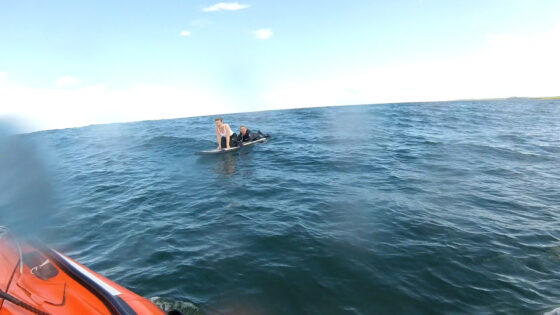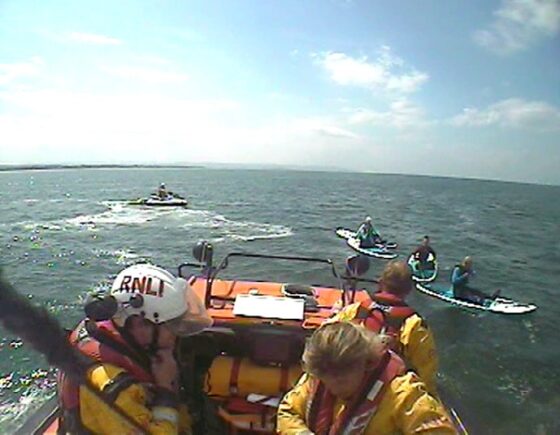
Brits warned over paddleboard dangers as RNLI callouts soar

New figures released by the Royal National Lifeboat Institution (RNLI) show a worrying rise in callouts involving stand-up paddleboards (SUPs) since 2020, as the popularity of paddleboarding continues to rise in the UK.
Interest in paddleboarding soared during the pandemic, with people drawn to spend more time outdoors and attracted by the social distancing that SUP naturally offers. Data gathered from Google Trends by Aquaplanet shows that searches for paddleboarding in the UK were up over 300 per cent in 2021 when compared to 2019.
The ease of getting into paddleboarding (low-cost SUP boards are sold in supermarkets and are readily available to hire all over the country) means its often called ‘the fastest-growing watersport in Britain’. MIN recently reported how one financial planner in Gloucester even decided to commute by SUP to save himself around £2,500 a year in petrol and parking costs.
As a result of this increased interest in paddleboarding, RNLI data shows the charity is facing a huge surge in callouts involving SUPs. The charity has saved the lives of 59 paddleboarders in the last 10 years, with a staggering 75 per cent (44) of those coming since 2020.
The data shows that lifeboat launches to paddleboard incidents went up 64 per cent in 2021 (144) from the previous year (88) while RNLI lifeguards responded to 132 per cent more paddleboard incidents in 2021 (504) than in the last year (217).
 Two paddleboarders are rescued by Anstruther RNLI in June, after drifting three-quarters of a mile out to sea. Photo courtesy of RNLI
Two paddleboarders are rescued by Anstruther RNLI in June, after drifting three-quarters of a mile out to sea. Photo courtesy of RNLIThe RNLI has now issued fresh safety advice to paddleboarders following two further incidents involving SUPs just last weekend.
On Sunday 26 June, five paddleboarders found themselves in trouble in the Bristol Channel and had to be rescued by RNLI volunteers. The group, all in their 20s and from south Wales, were paddling off Minehead, Somerset, when they found themselves being blown offshore by strong south-westerly winds.
On the same weekend in Scotland, Anstruther RNLI rescued two teenage girls who were clinging to the same paddleboard three-quarters of a mile out to sea.
Meanwhile, back in May, MIN reported how an entire family of four were rescued by the RNLI after being swept 1.5 miles out to sea on their paddleboards.
The four – a dad, mum, son, and family friend – were caught out by a combination of offshore wind and outgoing tide on The Wirral, Merseyside.
Hovercraft commander Chris Williams said the group had been ‘lucky’ that the alarm was raised quickly as the group were at risk of being swept further out to sea.
“Paddleboarding has become hugely popular and although the casualties were caught out by the wind and tide, they were wearing personal floatation devices, carrying mobile phones in waterproof pouches, and using their safety leashes,” says Williams.
 RNLI Hoylake locates the stricken paddleboarders off The Wirral. Photo courtesy of RNLI Hoylake
RNLI Hoylake locates the stricken paddleboarders off The Wirral. Photo courtesy of RNLI HoylakeIn total, in the 10 years from 2012-2021, the RNLI has saved the lives of 300 paddleboarders, kayakers or canoers and helped 6,361 people in distress. Figures on paddlesport accidents in the USA, published in MIN earlier this year, show a similarly worrying trend, which has been linked to a lack of safety training.
Safety is not a paramount concern among British paddleboarders either. Figures released on Wednesday (6Jul22) by sailing brand Helly Hansen — which works with the RNLI as its strategic charity partner — show that many Brits ignore lifesaving device when taking up water-based activities such as stand-up paddleboarding, kayaking and canoeing.
Of those surveyed, 62 per cent stated that they didn’t see a lifejacket or personal flotation device (PFD) as a necessary piece of kit when out on the water, with 1 in 5 of those surveyed admitting to not wearing one at all. The survey also revealed that 32 per cent of Gen Z would choose to take their smartphone with them while paddleboarding, over a PFD.
When asked why they chose not to wear one, the most common answer from almost a third of respondents (31.8 per cent) was being a confident swimmer. The next most popular reasons for not wearing a PFD were not owning one (24.5 per cent) and a dislike of wearing one (21.8 per cent). 30 per cent of respondents also said they would not change their plans on the water after looking at the weather forecast.
Emma Russell, marketing manager for Helly Hansen in the UK, Ireland, and Benelux, says: “The results highlight a persistent issue in the UK, that those taking part in water-based activities such as stand-up paddleboarding, kayaking and canoeing do not feel the need to wear a PFD during their time on the water. No matter the activity or competency level, everyone should see PFDs as an essential piece of kit that should always be worn.”
To try and combat the alarming trend, the RNLI has issued some fresh tips and guidance on how to stay safe when paddleboarding, including:
- Avoid going alone, where possible
- Always tell someone where you are going and when you’ll be back
- Check the weather forecast and avoid offshore winds
- Wear a suitable personal floatation device and clothing for the time of year
- Get the appropriate level of training
- Use a paddleboard with an appropriate leash
- Keep a means of calling for help attached to you in a waterproof pouch or close to hand
- If you get into trouble in the water, remember ‘Float to Live’: lean back, using arms and legs to stay afloat
Samantha Hughes of the RNLI’s Water Safety team says: “Paddleboarding, kayaking and canoeing are all extremely popular, especially during the summer months, and the RNLI has seen a large increase in our lifeboats and beach lifeguards going to the aid of people involved in these kinds of activities over the past few years.
“That’s why it’s important to be aware of some simple safety advice which could save your life.”
